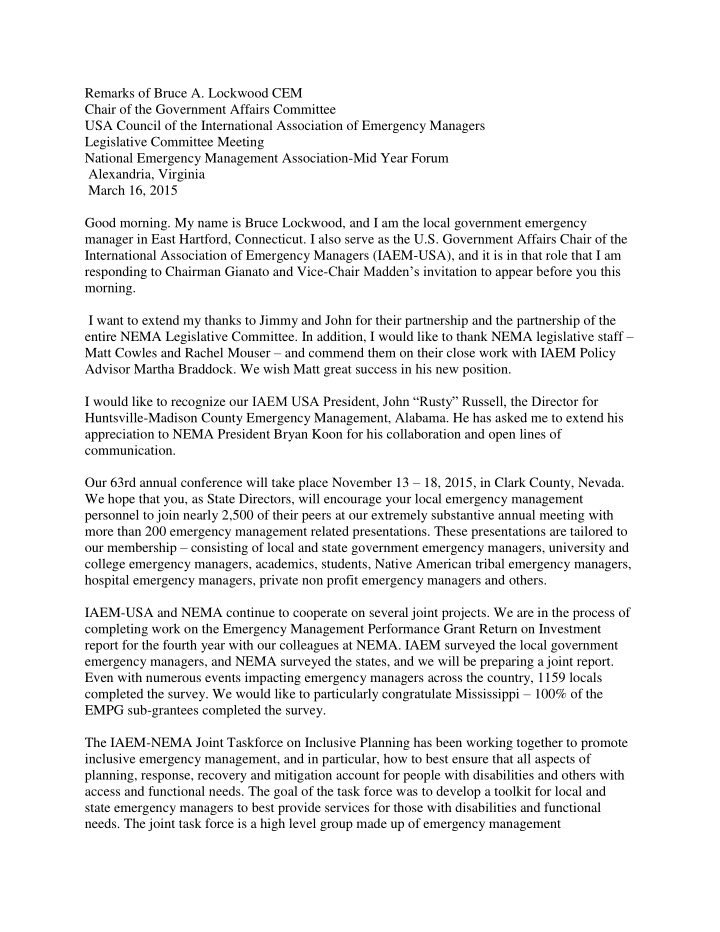



Remarks of Bruce A. Lockwood CEM Chair of the Government Affairs Committee USA Council of the International Association of Emergency Managers Legislative Committee Meeting National Emergency Management Association-Mid Year Forum Alexandria, Virginia March 16, 2015 Good morning. My name is Bruce Lockwood, and I am the local government emergency manager in East Hartford, Connecticut. I also serve as the U.S. Government Affairs Chair of the International Association of Emergency Managers (IAEM-USA), and it is in that role that I am responding to Chairman Gianato and Vice- Chair Madden’s invitation to appear before you this morning. I want to extend my thanks to Jimmy and John for their partnership and the partnership of the entire NEMA Legislative Committee. In addition, I would like to thank NEMA legislative staff – Matt Cowles and Rachel Mouser – and commend them on their close work with IAEM Policy Advisor Martha Braddock. We wish Matt great success in his new position. I would like to recognize ou r IAEM USA President, John “Rusty” Russell, the Director for Huntsville-Madison County Emergency Management, Alabama. He has asked me to extend his appreciation to NEMA President Bryan Koon for his collaboration and open lines of communication. Our 63rd annual conference will take place November 13 – 18, 2015, in Clark County, Nevada. We hope that you, as State Directors, will encourage your local emergency management personnel to join nearly 2,500 of their peers at our extremely substantive annual meeting with more than 200 emergency management related presentations. These presentations are tailored to our membership – consisting of local and state government emergency managers, university and college emergency managers, academics, students, Native American tribal emergency managers, hospital emergency managers, private non profit emergency managers and others. IAEM-USA and NEMA continue to cooperate on several joint projects. We are in the process of completing work on the Emergency Management Performance Grant Return on Investment report for the fourth year with our colleagues at NEMA. IAEM surveyed the local government emergency managers, and NEMA surveyed the states, and we will be preparing a joint report. Even with numerous events impacting emergency managers across the country, 1159 locals completed the survey. We would like to particularly congratulate Mississippi – 100% of the EMPG sub-grantees completed the survey. The IAEM-NEMA Joint Taskforce on Inclusive Planning has been working together to promote inclusive emergency management, and in particular, how to best ensure that all aspects of planning, response, recovery and mitigation account for people with disabilities and others with access and functional needs. The goal of the task force was to develop a toolkit for local and state emergency managers to best provide services for those with disabilities and functional needs. The joint task force is a high level group made up of emergency management
professionals, elected or appointed officials in the field, and subject matter experts particularly from jurisdictions who have been involved in ADA litigation on the emergency management systems and plans. The joint task force will sunset on April 30, 2015. We want to thank those involved for their dedication and work on this project. Shortly after leaving your annual meeting in Atlanta, NEMA President Bryan Koon reached out to IAEM proposing a webinar specific to emergency management lessons learned from the Ebola response in Dallas County, Texas. Working together, we successfully presented a webinar on October 30 that exceeded our 999 available registrations. In fact, we had 800 register in the first 24 hours. NEMA and IAEM participate in a number of coalitions and work groups. One of them is a very broad group called the Stafford Act coalition. Since the staff of the House Transportation and Infrastructure Subcommittee on Public Buildings, Economic Development and Emergency Management were not able to be here today, I would like to share some information that Rachel and Martha were briefed on last week. A bill is expected to be introduced in the next two weeks which will address among other issues administrative costs, de-obligation, and hazard mitigation grants for fire management assistance. In addition, we are following their effort to drive a larger discussion on disaster costs. On Wednesday morning they will hold the first in a series of round tables. The main purpose of this round table is to look at disaster data collected, including insured and uninsured losses, and federal disaster assistance beyond FEMA. Frequently round tables are much more productive and interesting than hearings. I would like to focus on several other congressional issues: First and foremost we are grateful for the Pre sident’s requested amount of $350 million for Emergency Management Performance Grant (EMPG) funding in his FY 2016 budget. In addition, we appreciate the fact that the administrative costs of FEMA for running this program will not be coming from the requested funding, allowing the entire amount to be available for distribution. The FY 2016 budget again proposes to move EMPG and Fire Fighter Assistance under a “First Responder Assistance Program” located in the State and Local Programs account. Congress rejected this proposal last year and we will urge them to reject it again. It is vital that EMPG remains a separate account due to its fundamentally different nature from all the other FEMA preparedness grants. We are encouraging members of the House of Representatives to include EMPG funding in their FY 2016 appropriations priority letters to the House Appropriations Subcommittee on Homeland Security, which are due by March 26, 2015. We urge Members of the Senate to include EMPG funding in their FY 2016 appropriations priority letters to the Senate Appropriations Subcommittee on Homeland Security which are due by April 24, 2015. It is important that we emphasize that EMPG is not an ear mark. With so many new members of Congress as well as changes in key committee chairs and ranking members and new staff, it is very important that state and locals increase their efforts to provide information on what emergency managers actually do, and why it matters.
Recommend
More recommend